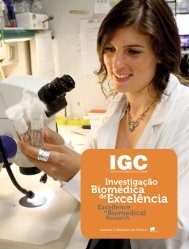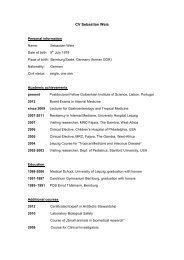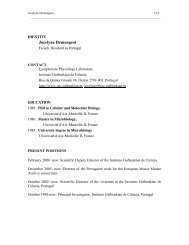organisation - the Instituto Gulbenkian de Ciência
organisation - the Instituto Gulbenkian de Ciência
organisation - the Instituto Gulbenkian de Ciência
- No tags were found...
You also want an ePaper? Increase the reach of your titles
YUMPU automatically turns print PDFs into web optimized ePapers that Google loves.
INFECTION<br />
AND IMMUNITY<br />
Michael Parkhouse Principal Investigator<br />
PhD in Biochemistry, University of London<br />
Head Immunology, Institute Animal Health, Pirbright, UK<br />
Director, Centro Nacional <strong>de</strong> Biotechnologia, Madrid, Spain<br />
Special Appointment-equivalent to University Professor, National Institute for Medical Research, Mill Hill, London<br />
Principal Investigator at <strong>the</strong> IGC since 2000<br />
The <strong>the</strong>me of <strong>the</strong> group is <strong>the</strong> reciprocal adaptation between an infectious<br />
organism and its host. The necessity to recognise and <strong>de</strong>stroy invading pathogens<br />
has played a crucial role in <strong>the</strong> evolution of <strong>the</strong> immune system of both<br />
vertebrates and invertebrates. At <strong>the</strong> same time, pathogens, in particular viruses,<br />
have evolved strategies to manipulate <strong>the</strong> immune system. An efficient<br />
immune system must select <strong>the</strong> immune effector mechanism most appropriate<br />
to <strong>the</strong> biology of <strong>the</strong> pathogen. Thus, <strong>the</strong> study of how pathogens control immune<br />
responses will offer novel approaches for <strong>the</strong> manipulation of <strong>the</strong> immune<br />
responses in health and disease, with novel vaccines and strategies to<br />
downregulate <strong>the</strong> immune system (e.g. inflammation) being <strong>the</strong> most obvious<br />
possibilities. Therefore, we are i<strong>de</strong>ntifying and characterising virus host evasion<br />
genes directed towards subversion of cell biology and innate immunity. The two<br />
viruses that we have selected are Herpesvirus and <strong>the</strong> African Swine Fever Virus.<br />
EVALUATING AND CONTROLLING THE RISK OF AFRICAN SWINE FEVER (ASF)<br />
IN THE EU<br />
The aim is to provi<strong>de</strong> new tools and strategies for <strong>the</strong> control of ASF in Africa and<br />
reduce <strong>the</strong> risk of importation and/or spread of <strong>the</strong> disease in EU member states.<br />
GROUP MEMBERS<br />
Rute Nascimento (Post-doc, started in July )<br />
Sílvia Correia (Post-doc)<br />
Helena Costa (PhD stu<strong>de</strong>nt)<br />
Sónia Ventura (PhD stu<strong>de</strong>nt)<br />
Emanuel Costa (Research Technician)<br />
COLLABORATORS<br />
Sun Huaichang (College of Veterinary Medicine, Yangzhou University, China)<br />
Alexandre Leitão (Faculda<strong>de</strong> <strong>de</strong> Medicina Veterinária, Universida<strong>de</strong> Técnica<br />
<strong>de</strong> Lisboa, Portugal)<br />
John Sinclair (University of Cambridge, UK)<br />
Steve Goodbourn (St. George's Hospital, University of London, UK)<br />
FUNDING<br />
Framework Programme 7 (FP7), European Commission<br />
Fundação para a Ciência e a Tecnologia (FCT), Portugal<br />
We produced B602L, p54, A104R and K205R recombinant proteins which have<br />
been used as antigens to field test ASFV isolates in new recombinant ELISAs by<br />
Dr Carmina Gallardo, CISA-INIA. As <strong>the</strong> K205R protein revealed high IgM titres,<br />
it has been produced and sent to Dr Carmen Vela, INGENASA, to <strong>de</strong>velop a new<br />
commercial kit able to <strong>de</strong>tect recently ASFV infected animals. An additional ASFV<br />
Interferon evasion gene has been i<strong>de</strong>ntified using luciferase reporter assays.<br />
INHIBITION OF THE RESPONSE OF THE AFRICAN SWINE FEVER VIRUS AGAINST<br />
HOST INTERFERON<br />
Our objective is to <strong>de</strong>termine <strong>the</strong> mechanisms and consequences of three nonhomologous<br />
host evasion genes (I329L, K205R and A276R) of <strong>the</strong> economically<br />
important, frequently fatal African Swine Fever Virus (ASFV). All three genes<br />
inhibit a major component of innate immunity, <strong>the</strong> Interferon (IFN) response,<br />
and may have practical application through <strong>the</strong> <strong>de</strong>velopment of novel pharmaceuticals<br />
that manipulate IFN responses and through <strong>the</strong> construction of an<br />
attenuated gene <strong>de</strong>letion ASFV vaccine.<br />
We i<strong>de</strong>ntified <strong>the</strong> I329L gene as an inhibitor of TLR3 signalling pathway through<br />
targeting of TRIF (Ventura et al. 2012, in prep). The K205R gene was i<strong>de</strong>ntified<br />
as an interacting partner of STAT2, <strong>the</strong>refore inhibits <strong>the</strong> host antiviral response<br />
by inhibiting <strong>the</strong> expression of interferon stimulating genes (ISGs) (Correia et al<br />
2012, in prep). Definition of <strong>the</strong>ir cellular targets and impact on cellular processes<br />
is a necessary step prior to <strong>the</strong> construction of a <strong>de</strong>letion mutant virus vaccine.<br />
MECHANISM AND CONSEQUENCES OF AN IL-8 INDUCING HERPESVIRUS GENE<br />
The project builds on our own observations and experience with UL76 gene<br />
from Human Cytomegalovirus (HCMV), a novel virus host evasion gene previously<br />
lacking a function and, with <strong>the</strong> exception of <strong>the</strong> herpesviruses, still without<br />
any homologue in <strong>the</strong> database. The main objective of this project is to <strong>de</strong>fine<br />
<strong>the</strong> mechanisms employed by UL76 to induce IL-8 expression and G2/M cell<br />
cycle arrest. Un<strong>de</strong>rstanding this virus strategy for manipulating cell division and<br />
stimulating IL-8 expression may be exploitable for <strong>the</strong> rational control of <strong>the</strong>se<br />
important infections in humans, for example, <strong>the</strong> construction of attenuated<br />
herpes virus vaccines, and <strong>the</strong> <strong>de</strong>velopment of possible novel approaches for<br />
<strong>the</strong> manipulation of host cell biology in health and disease.<br />
We <strong>de</strong>monstrated that UL76 induces IL-8 expression through NF-kB activation<br />
using <strong>de</strong>letion mutants of IL-8 promoter luciferase reporter. The activation of<br />
NF-kB by UL76 is <strong>de</strong>pen<strong>de</strong>nt of IKK-beta and <strong>the</strong> <strong>de</strong>gradation of IKB-alpha proteins.<br />
Moreover, expression of UL76 results in p65 translocation to <strong>the</strong> nucleus<br />
and in increased binding of p65 to <strong>the</strong> IL-8 promoter region as shown by chromatin<br />
immunoprecipitation.<br />
IGC ANNUAL REPORT ‘11<br />
RESEARCH GROUPS<br />
54






